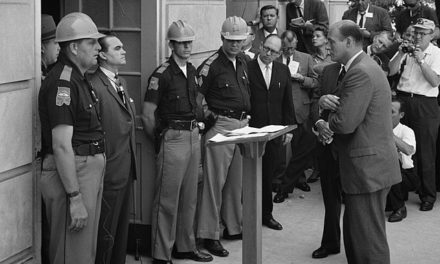From Better Institutions:
There seems to be an uptick in freeway news lately, so I put together a highway edition of my semi-daily news roundup last week, including the updates on the apparent death of the Columbia River Crossing, the 1960s-style “Opportunity Corridor” proposed in Cleveland, and a broader anti-freeway movement taking hold in the Midwest. The self-defeating nature of highway construction and expansion is noted in each of these articles, as is the physical scarring of communities that usually accompanies these projects. Lost in the discussions of induced demand (focused on the highway itself) and community displacement and segregation (focused on local residents and businesses) is the intersection of these two issues, local traffic.
 |
| Columbia River Crossing from Vancouver, WA to Portland, OR in 1965, photo from WSDOT. |
Induced demand in the context of vehicle capacity simply means that building more space for cars encourages more people to use them. If I live in the suburbs and the city widens the freeway into downtown I might take a few extra trips into the city every month or decide that taking a job in the city is now feasible. The increase in average highway travel speeds also brings more distant suburbs and exurbs within driving distance, which encourages more development at the current sprawl boundary and beyond. These and other effects lead to more cars using the highway until the excess capacity is soaked up and traffic is just as bad as it ever was. According to most studies, about 80-90% of the excess capacity is soaked up within just five years.
This makes for a strong argument against highway expansion, but it ignores the impacts on local streets, which are far more severe. The problem here is obvious: unless 100% of the new highway users are bypass traffic–none of them using the highway to get into the city itself–local roads have to deal with a huge influx of additional vehicles. Many of those vehicles aren’t bypass traffic, of course, so local streets (and their residents) are burdened with their presence and the congestion they bring. And while federal- or state-owned highways can sometimes afford to increase their capacity, local roads usually can’t. Besides being a poor choice from an return-on-investment and livability perspective, widening local streets to cope with the increase in vehicles is usually physically impossible–city centers are already built out and, thankfully, few people support tearing down homes and businesses just to expand local roads.
In an effort to visualize this phenomenon, I’ve made this simple graph, which shows a schematic of capacity vs total traffic on highways and local roads before and after highway expansion:
 |
| Car use rises to meet increased highway capacity, and this has negative impacts on local traffic. |
This illustrates two important facts: first, that increasing capacity doesn’t actually improve the traffic situation on the highway; second, that it makes local traffic worse. The net result is to improve the lot of suburban and outer-city drivers at the expense of close-in city-dwellers.
To see why, imagine this scenario: you live 20 miles outside the city and want to get downtown, so you take the freeway there. The highway part of your trip used to take 30 minutes, but thanks to the new lanes it now only takes you 20 minutes. The last mile of your trip has slowed since there’s a bit more local traffic, but it only increases from three minutes to five. All told, your trip time has decreased from 33 minutes to 25–great!
Now imagine you live in the city, five miles from the city center. It used to take your bus 20 minutes to get downtown, but unfortunately as a city resident you don’t reap many benefits from the additional highway capacity. Instead, your trip is entirely on local roads, so all those extra cars coming into the city only slow you down. The trip that used to take you twenty minutes now takes thirty. The suburban visitor/commuter saved about ten minutes, and the city resident lost about ten, and all it cost was a few hundred millions dollars in construction and millions more in demolished buildings and businesses that are no longer producing revenue for the city. Money well spent, right?
There’s only one way this equation makes sense, and it’s dependent on the view that suburban traffic is more valuable than urban traffic. Tens or hundreds of millions of dollars is a lot to spend unless you sincerely believe that facilitating 30-mile trips is more important than encouraging five-mile ones, and that’s a pretty insane view to take if you care about the economy, the environment, or peoples’ health. Likewise, it illustrates a very clear preference for the needs of (often distant) cars over the needs of (usually local) transit. It also ignores the fact that the person living in the city is probably dealing with local traffic on a daily basis, while the suburb dweller is often only visiting on occasion, so the negative is very likely to outweigh the bad.
City leaders would be much better served spending that money on their actual constituents. If worse local traffic–including for cars–is a price they’re willing to pay for better suburban access to the city (as many appear to be) surely they’d be willing to pay the same price to install a few bus-only lanes in heavily-trafficked regions to ensure that someone in the city actually sees some benefit. As far as I know, road paint is fetching a much lower price than concrete these days.




